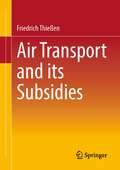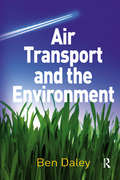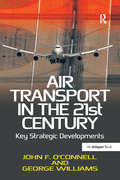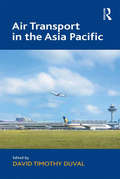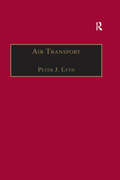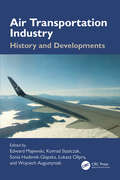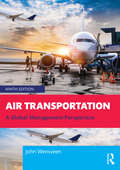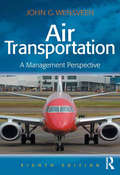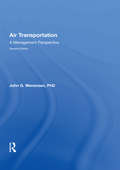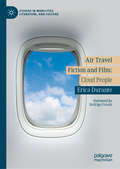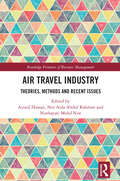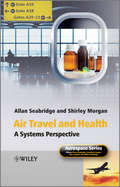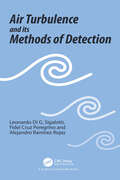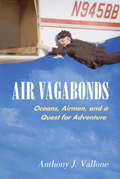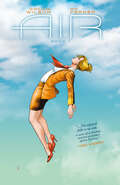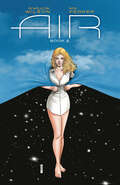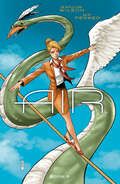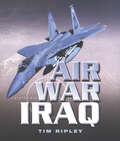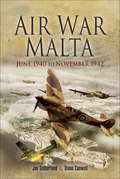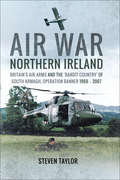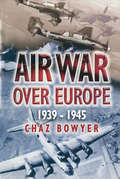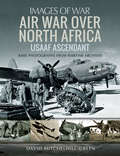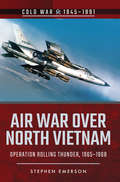- Table View
- List View
Air Transport and its Subsidies
by Friedrich ThießenThe book deals with the subsidies of air transport. It shows which subsidies are used to promote air transport and how the subsidies influence the various segments of air transport. The types of subsidies dealt with correspond to the OECD's delimitation. In addition to tax breaks and transfers, capital subsidies, infrastructure subsidies, regulatory deficits and non-internalised externalities are also included. The areas of air transport in which subsidies are identified are airports, airlines and air traffic control. Furthermore, aircraft manufacturers and research as well as air transport regulation, the behaviour of MPs and airport-related infrastructure are dealt with. The subject is of general and long-term interest. The book is the most comprehensive and systematic compilation of subsidies available. The result is that air transport is permeated by a largely uncoordinated system of subsidies in all its areas, the overall effects of which have not been recorded until today.
Air Transport and the Environment
by Ben DaleyAir Transport and the Environment provides an overview of the main issues relating to aviation environmental impacts. It explains the challenge facing policymakers in terms of sustainable development, focusing on the importance of balancing the industry's economic, social and environmental costs and benefits, both for people living now and for future generations. Individual chapters review the current scientific understanding of the main aviation environmental impacts: climate change, local air pollution and aircraft noise. Various responses to those issues are also considered, including a range of policy options based on regulatory, market-based and voluntary approaches. Key concepts such as environmental capacity, radiative forcing and carbon offsetting are explained. In addition, the book emphasises the main implications of aviation environmental issues for policymakers and for the management of the air transport industry. Debates about the environmental impacts of flying often generate strongly polarised reactions, yet this book adopts a constructive approach to the subject and attempts to present the environmental issues in a clear, straightforward manner. It aims to provide a policy-relevant synthesis of a wide range of perspectives rather than advocating one particular viewpoint. Yet the central purpose of this book is to bring the sustainable development challenge facing the air transport industry to the fore, and so to inform effective policy responses. Air transport plays a critical role in supporting economies and societies that are increasingly interconnected by globalisation; this book presents the view that the vital economic and social benefits of the air transport industry should not be lost - and in fact could be distributed far more widely and equitably - but that the environmental impacts of air transport nevertheless require urgent and effective management. Air Transport and the Environment has been written primarily for professionals in the air transport industry, policymakers and regulators. It is also intended for use by academic researchers, students and others who are interested in the complex relationship between air transport and the environment.
Air Transport in the 21st Century: Key Strategic Developments
by George Williams John F. O'ConnellAirlines are buffeted by fluctuating political and economic landscapes, ever-changing competition, technology developments, globalization, increasing deregulation and evolving customer requirements. As a consequence all sectors of the air transport industry are in a constant state of flux. The principle aim of this book is to review current trends in the airline industry and its related suppliers, thereby providing an insight into the forces that are changing its dynamics. The factors that are reshaping the structure of the industry are examined with a view to identifying the key issues whose impact will be critical in the future. The book features two very distinct sections. The first contains short contributions from industry executives at CEO/VP level from airlines, aircraft/engine manufacturers, safety and navigational provider organisations, who have set out their take of where the airline industry is heading. This commercial input sets the scene for the book and provides the bridge to the second section, which is composed of 18 chapters written by distinguished academic authors. Each chapter presents a valuable insight into a specific area of the air transport industry, including: airlines, airports, cargo, deregulation, the environment, navigation, strategy, information technology, security and tourism. The shared objective of the authors is to describe and explain the core competencies that are determining the current shape of the industry and to examine the forces that will change its direction going forward. The book is written in a management style and will appeal to all levels of personnel who work for airlines across the world. It is also written for airport authorities, aerospace manufacturers, regulatory and government transportation agencies, researchers and students of aviation management, transport studies, tourism and the wider air transport industry.
Air Transport in the Asia Pacific
by David Timothy DuvalAir transport in the Asia Pacific has undergone significant transformation in the last three decades. What was once a region in the shadow of larger and more prosperous continents such as North America and Europe is now at the forefront of expansion in commercial air-service networks, frequency and capacity, and the overall growth in the contribution of air transport to economies on regional and, in many cases, individual country levels. Despite this, it represents an area that is generally under-represented in the commercial air-transport academic literature. Air Transport in the Asia Pacific seeks to fill this gap. Against this context, the aim of the volume is to offer a contemporary snapshot of current academic research into commercial air transport in the Asia Pacific. While one volume cannot realistically address the complete range of identifiable issues, this book provides timely, specific and research-based studies authored by leading academics and practitioners.
Air Transport: European Commercial Air Transport Since 1945 (Studies in Transport History)
by Peter J. LythEach volume in this new series is a collection of seminal articles on a theme of central importance in the study of transport history, selected from the leading journal in the field. Each contains between ten and a dozen articles selected by a distinguished scholar, as well as an authoritative new introduction by the volume editor. Individually they will form an essential foundation to the study of the history of a mode of transport; together they will make an incomparable library of the best modern research in the field.
Air Transportation Industry: History and Developments
by Edward Majewski Konrad Stasiczak Sonia Huderek-Glapska Łukasz Olipra Wojciech AugustyniakAir Transportation Industry considers the influence of political, legal, economic, social, and technological factors on the developments in the industry. It provides a brief historical background of the air transport industry, the determinants of the changes in the airline business, and adaptation processes that resulted in the evolution of business models and structural changes in the industry.Utilizing a unique database containing the characteristics of more than 16,000 air carriers worldwide, the book discusses key findings related to changes in the transport capacity of airlines operating at different points in time, including the length of the lifecycle and reasons for termination of activity, types, and geographical scope of operations. It also explores the impacts of global and regional-scale legal regulations.The book will interest air transportation and airport operations researchers. It can also serve as a reference for management and operations transportation students in logistics, air transportation, and economics courses.
Air Transportation: A Global Management Perspective
by John WensveenNow in its ninth edition, Air Transportation: A Global Management Perspective by John Wensveen is a well-proven, accessible textbook that offers a comprehensive introduction to the theory and practice of air transport management. In addition to explaining the fundamentals, the book transports the reader to the leading edge of the discipline, using past and present trends to forecast future challenges and opportunities the industry may face, encouraging the reader to think deeply about the decisions a manager implements. The word "Global" has been added to the subtitle for this edition, reflecting an increased emphasis on worldwide operations, including North America, Latin America/Caribbean, Europe, Asia-Pacific, the Middle East, and Africa. The ninth edition focuses on the "Age of Acceleration," addressing trends related to emerging technologies, such as autonomy, artificial intelligence, augmented reality, virtual reality, 3-D printing, data analytics, blockchain, cybersecurity, etc. New material includes extra information on airport management and operations, air carrier business models, aviation risk, safety and security, and how changing political landscapes impact the aviation industry. Enhanced content is supported by the addition of new chapters and online supplemental resources, including PowerPoint presentations, chapter quizzes, exam questions, and links to online resources. This wide-ranging textbook is appropriate for nearly all aviation programs that feature business and management. Its student-friendly structure and style make it highly suitable for modular courses and distance-learning programs, or for self-directed study and continuing personal professional development.
Air Transportation: A Management Perspective
by John G. WensveenAir Transportation: A Management Perspective by John Wensveen is a proven textbook that offers a comprehensive introduction to the theory and practice of air transportation management. In addition to explaining the fundamentals, the book transports the reader to the leading edge of the discipline, using past and present trends to forecast future challenges and opportunities the industry may face, encouraging the reader to really think about the decisions a manager implements. Written in an easy-to-read, easy-to-understand style, the Eighth Edition modernizes the text focusing on newly emerging management trends, innovative technology, and an increased emphasis on global changes in the industry that will change the future of aviation. New and updated material has been added throughout the text including mini case examples and supplemental presentation materials for each chapter. Air Transportation: A Management Perspective is suitable for almost all aviation programs that feature business and management. Its student-friendly structure and style make it highly suitable for modular courses and distance-learning programs, or for self-directed study and continuing personal professional development.
Air Transportation: A Management Perspective
by John WensveenNow in its Seventh Edition, Air Transportation: A Management Perspective by John Wensveen is a proven textbook that offers a comprehensive introduction to the theory and practice of air transportation management. In addition to explaining the fundamentals, this book now takes the reader to the leading edge of the discipline, using past and present trends to forecast future challenges the industry may face and encouraging the reader to really think about the decisions a manager implements. The Seventh Edition brings the text right up to date with a new opening chapter, titled 'The Airline Industry: Trends, Challenges and Strategies', setting the context for all that follows within the book, and a new section within 'International Aviation' that explores the new airline business models. New and updated material has been added throughout the text and overall presents a more international perspective. Arranged in sharply focused parts and accessible sections, the exposition is clear and reader-friendly. Air Transportation: A Management Perspective is suitable for almost all aviation programs that feature business and management. Its student-friendly structure and style make it highly suitable for modular courses and distance-learning programmes, or for self-directed study and continuing personal professional development.
Air Travel Fiction and Film: Cloud People (Studies in Mobilities, Literature, and Culture)
by Erica DuranteAir Travel Fiction and Film: Cloud People explores how, over the past four decades, fiction and film have transformed our perceptions and representations of contemporary air travel. Adopting an interdisciplinary approach, the book provides a comprehensive analysis of a wide range of international cultural productions, and elucidates the paradigms and narratives that constitute our current imaginary of air mobility. Erica Durante advances the hypothesis that fiction and film have converted the Airworld—the world of airplanes and airport infrastructures—into a pivotal anthropological place that is endowed with social significance and identity, suggesting that the assimilation of the sky into our cultural imaginary and lifestyle has metamorphosed human society into “Cloud People.” In its examination of the representations of air travel as an epicenter of today’s world, the book not only illustrates a novel perspective on contemporary fiction, but fills an important gap in the study of globalization within literary and film studies.
Air Travel Industry: Theories, Methods and Recent Issues (Routledge Frontiers of Business Management)
by Azizul Hassan Nor Aida Abdul Rahman Nurhayati Mohd NurAs the air travel industry begins to emerge from the COVID-19 restrictions, new research must be undertaken to survey the changing business landscape. This book examines existing air travel literature, illustrates the current theories in the field, and suggests research methods for integrating them in fieldwork. The book begins by surveying the landscape of air travel research and examining key theoretical frameworks such as grounded theory, institutional theory, prospect theory, and the theory of planned behavior. It then explores when qualitative and quantitative research methods are appropriate for use in air travel research, and how they can be applied successfully. Gathered contributors from Southeast Asia and the Middle East highlight some of the latest issues, including the impacts of COVID-19 on airfreight, airline catering, and passenger perceptions of security and safety. Future directions for research are also proposed. This book will appeal to researchers and postgraduate students in the fields of air transport or aviation management, tourism marketing, and consumer behavior.
Air Travel Partnerships: How to Create Greater Value through Collaboration
by Nawal K. TanejaWhile change in the aviation sector is hardly a new phenomenon, going forward the rate of change will accelerate due to the emergence, convergence, and intersection of powerful internal and external forces. To deal with the accelerating change in the marketplace, stakeholders in the travel ecosystem need to deepen collaboration that is productive to (1) building adaptable, resilient, and lean businesses, (2) achieving growth and innovation, (3) elevating traveler experience to a much higher level, and, at the same time, (4) reducing the impact on the environment.Undoubtedly, while some innovations implemented by different aviation business sectors—to become more adaptable, more resilient, and leaner as well as to improve customer experience—have been adding some value, the innovations being introduced have been transactional, fragmented, and incremental. What is needed is a step change in proactive collaboration among different stakeholders in the air travel ecosystem at the holistic level, to cocreate value for travelers in terms of experience (relating to simplicity, convenience, and speed) and for businesses to adapt in order to reduce costs and increase profit margins.This book focuses on four types of organizations within the air travel sector: airlines, airports, aircraft manufacturers, and travel intermediaries. It provides a framework, tools, and insights to enhance collaborations by design in an age of increasing uncertainty.Air Travel Partnerships is essential reading for all executives and senior managers within airlines, airports, and air transport supporting industries.
Air Travel and Health
by Allan Seabridge Shirley MorganProviding a detailed examination of the issues that affect the long term health of aircrew, cabin crew and passengers, Air Travel and Health offers guidance to engineers designing aircraft in the difficult field of legislation and product liability. Examining the facts, anecdotes and myths associated with health and travel, Seabridge and Morgan draw balanced conclusions on which the aircraft operations and design communities can act to provide cost-effective solutions. The authors present a useful reference for aircrew, regulatory authorities, engineers and managers within the aerospace industry, and medical and human factor specialists, as well as an informative resource for undergraduate and graduate students.
Air Turbulence and its Methods of Detection
by Leonardo Di Sigalotti Fidel Cruz Peregrino Alejandro Ramírez-RojasThe book is a concise guide dealing with the subject of air turbulence and its methods of detection with particular applications to aviation turbulence. It begins with a general description of turbulence and provides a background into the nature and causes of atmospheric turbulence that affect aircraft motion, giving updates on the state-of-the-art research on clear air turbulence (CAT). Important physical processes leading to the Kelvin-Helmholtz instability, a primary producer of CAT, are also explained. The several categories of CAT along with its impact on commercial aviation are also presented in a separate chapter, with particular emphasis on the structural damages to planes and injuries. The central theme of the book deals with both the earlier and the latest CAT detecting methods and techniques for remote and in situ sensing and forecasting. A concise presentation of new technologies for reducing aviation weather-related accidents is also offered. A chapter on the weather accident prevention project of the NASA aviation safety program is also included. Additionally, the book ends with a full description of the recent research activities on CAT and future challenges in turbulence detection, prediction and avoidance.
Air Vagabonds
by Anthony J. ValloneAir Vagabonds is the story of the amazing, true (mis)adventures of a band of rogues piloting aircraft alone into exotic and deadly destinations.In the late 1970s and through the 1980s the demand for light aircraft eclipsed anything seen before or since. This created the need for a small air force of pilots--ferry pilots--willing to fly thousands of planes to clients in every corner of the globe. Long-range solo flying is not for everyone, and it attracted a cast of eccentric, unforgettable mavericks who flew from one misadventure to the next, battling storms, desert winds, aircraft malfunctions, primitive navigational aids, loneliness, chemical imbalances, and dangerous Third World politics. Some carried on international scams and love affairs, some were lost at sea, some imprisoned by African despots. They're all here, described with humor and high drama by one of their own, a survivor with phenomenal recall, a knack for distinguishing character from bluster, and a great ear for dialogue and aviation lore.
Air Volume 1
by G. Willow WilsonA new edition of the first of four thrilling volumes in this mind-bending, Eisner-nominated science fiction mystery graphic novel series! Acrophobic flight attendant Blythe has just fallen for a mysterious traveler—who may or may not be a terrorist—and she's about to embark on the strangest journey of her life.Searching for him, Blythe will crash-land into a web of technological conspiracies, dark politics and secret organizations. When she learns that she is the only person able to control flight and reality, with science so advanced it might be magic, she'll have to break the rules of time and space for answers. But will she reach new heights...or free-fall? By award-winning author G. Willow Wilson (Invisible Kingdom, Ms. Marvel, The Bird King) and acclaimed illustrator M.K. Perker (The New Yorker, Mad Magazine, Fables), AIR is a high-stakes, high altitude adventure about where limits lie, and what happens when they're not only broken...but remade."...I've enjoyed AIR to no end—it starts off as Rushdie and then parachutes off into Pynchon."–Neil Gaiman "The fantasy is real, and the reality is fantastic. AIR is a compelling and completely original read that thrills, surprises and delights."–Gail Simone "An entertaining read with some serious points to make about the fluidity of borders in the 21st century."–The Onion
Air Volume 2
by G. Willow WilsonThe adventure continues in Volume 2 of this genre-bending, death-defying, Eisner-nominated series by acclaimed author G. Willow Wilson (Invisible Kingdom, Ms Marvel, The Bird King) and celebrated illustrator M.K. Perker (The New Yorker, Mad Magazine, The Unwritten, Fables).Acrophobic flight attendant Blythe has left her safe, sterile life for a world of strange danger. And she's been taken under the wing of none other than Amelia Earhart herself—alive and soaring after all these years. How did Amelia survive her disappearance? What is the centuries-old secret that enables her to travel the known and unknown world, using nothing but dreams for fuel? And what is her real agenda? The answers find Blythe charting a course for the edge of reality—and the heart of the man she loves."...I've enjoyed AIR to no end—it starts off as Rushdie and then parachutes off into Pynchon."—Neil Gaiman"An entertaining read with some serious points to make about the fluidity of borders in the 21st century."—The Onion
Air Volume 3
by G. Willow WilsonWith the help of none other than Amelia Earhart, Blythe has begun to harness her perplexing power; one step closer to controlling time and space.But when the fragmented trail of her mysterious love leads her to dangerous territory of double agents, metalhead jihadists, and an alarming backstory, Blythe will need to control more than just reality: she'll need to manage her own suspicions—and her addiction.What is the real truth about Zayn? And when Blythe can't depend on her pills, can she depend on herself?Find out in Volume 3 of this high-altitude, high-stakes, Eisner-nominated adventure by acclaimed author G. Willow Wilson (Invisible Kingdom, Ms Marvel, The Bird King) and celebrated illustrator M.K. Perker (The New Yorker, Mad Magazine, The Unwritten, Fables).
Air Volume 4
by G. Willow WilsonPREPARE FOR LANDINGBlythe's metaphysical training is over, and one final test stands between her and her future as the greatest hyperprax pilot to ever live.Caught between opposing organizations: the dazzling explorers who support and need her, and the cutthroat conspirists who have targeted her, Blythe must find her own path in her most perilous journey yet: to pass her test, find her future, and make sense of a senseless universe—for Good. It will take her deep into the past and far into a future she was never meant to see...but may be able to re-shape.The exhilarating conclusion of the brilliant, Eisner-nominated series!
Air War Iraq (Battlefield Britain Ser.)
by Tim RipleyThe book is a photo-journalistic record of the vitally important role that aviation played in the recent liberation of Iraq. It follows the part that American, British and Australian airpower played in each theatre of the campaign. It includes the many different missions that aircraft were tasked with, precision bombing, support of ground forces, clandestine air drops. Covering the initial build-up to the rapid and record-breaking advance on the capital it uses dramatic action photographs and first-hand accounts to portray the events as they unfolded.
Air War Malta: June 1940 to November 1942
by Diane Canwell Jon SutherlandThis is the story of the historic air defense of Malta by the WRAF against the combined attacking forces of the Italian and German air forces. The island was poorly equipped when Italy declared war on Britain in June 1940 and its only defense against air attack at the outset of war were 34 heavy and 8 light antiaircraft guns, one radar set and four Gladiator biplane fighters. The first air raids came on 11 July and from then on were an almost daily feature of life for the Maltese occupants and the island was in a state of siege. The loss of this strategic point in the central Mediterranean would threaten the major supply routes to the British Army in North Africa and deprive the Royal Navy of a vital base. Although hard-pressed at home and standing alone against Hitlers Europe, every effort was made by Britains government to get supplies, munitions and replacement aircraft to enable the island to withstand the naval and airborne onslaught. Convoy after convoy attempted to get through, Hurricane and Spitfire fighters were launched from aircraft carriers with only sufficient fuel for a one-way trip to the island. Many did not survive these heroic flights. Many famous British ships were lost due to torpedo and air attack, including the carriers Ark Royal and Eagle and the battleship Barham. The siege was finally raised on 20 November 1942.This book follows the islands wartime history, describing the heavily outnumbered WRAF defense against the many air-raids and how the small bomber force took the battle to Italian shores. It is a tale of outstanding bravery by the British forces and the Maltese people.
Air War Northern Ireland: Britain's Air Arms and the 'Bandit Country' of South Armagh, Operation Banner 1969–2007
by Steven TaylorThe story of the little-known battles between British helicopters and Provisional IRA units equipped with heavy machine guns, RPGs, and SAMs—includes photos. Famously dubbed &“Bandit Country&” by a UK government minister in 1975, South Armagh was considered the most dangerous part of Northern Ireland for the British Army and Royal Ulster Constabulary during the years of violence known as the Troubles that engulfed the province in the last three decades of the twentieth century. This was also true for the helicopter crews of the RAF, Royal Navy, and Army Air Corps who served there. Throughout the Troubles, the Provisional IRA&’s feared South Armagh brigade waged a relentless campaign against military aircraft operating in the region, where the threat posed by roadside bombs made the security forces highly dependent on helicopters to conduct day-to-day operations. From pot-shot attacks with Second World War-era rifles in the early days of the conflict to large-scale, highly coordinated ambushes by PIRA active service units equipped with heavy machine guns, rocket-propelled grenade launchers and even shoulder-launched surface-to-air missiles (SAMs), the threat to British air operations by the late 1980s led to the arming of helicopters operating in the border regions of Northern Ireland. Drawing on a wide range of sources, including official records and the accounts of aircrew, this book tells the little-known story of the battle for control of the skies over Northern Ireland&’s &“Bandit Country.&”
Air War Over Europe, 1939–1945: 1939-1945
by Chaz BowyerChaz Bowyer, arguably the most authoritative air historian of his generation, tackles the broad sweep of air operations in the European theatre in this book. Initially, the Luftwaffe attempted to dominate the skies, and very nearly succeeded. The valiant defence of the UK by the RAF in the Battle of Britain ranks among the greatest feats of arms in our country's history. The development of aircraft types and the descriptions of the actions that they and their pilots and crew fought make for great reading.
Air War Over North Africa: USAAF Ascendant (Images of War)
by David Mitchelhill-GreenThe decisive role of U.S. Army Air Forces in North Africa is vividly chronicled in this WWII pictorial history featuring rare wartime photographs. In 1942, General Erwin Rommel launched a surprise offensive in North Africa that brought a renewed threat to the Allied forces in the Middle East. United States Army Air Forces were quickly transferred to Egypt to assist the beleaguered British. Unaccustomed to the sprawling deserts of North Africa, the American airmen were confronted by sandstorms, flooding rains, extremes of temperature and primitive living conditions. Beyond these daunting conditions, they were pitted against an experienced and determined enemy. U.S. air power nevertheless played a decisive role in the Allied invasion of Northwest Africa and the subsequent surrender of Axis forces in Tunisia in May 1943. Later bombing missions flown from North Africa struck Axis targets across Europe and supported the Allied invasions of Sicily and mainland Italy. Featuring rare photograph from wartime archives, this volume in the Images of War series presents an illustrated account of U.S. fighter aircraft and bombers—including the iconic B-17 Flying Fortress, P-38 Lightning and B-24 Liberator—and the aircrews that fought to establish ascendancy over North African skies and beyond.
Air War Over North Vietnam: Operation Rolling Thunder, 1965–1968 (Cold War, 1945–1991)
by Stephen EmersonIn early 1965 the United States unleashed the largest sustained aerial bombing campaign since World War II, against North Vietnam. Through an ever escalating onslaught of destruction, Operation Rolling Thunder intended to signal Americas unwavering commitment to its South Vietnamese ally in the face of continued North Vietnamese aggression, break Hanois political will to prosecute the war, and bring about a negotiated settlement to the conflict. It was not to be. Against the backdrop of the Cold War and fears of widening the conflict into a global confrontation, Washington policy makers micromanaged and mismanaged the air campaign and increasingly muddled strategic objectives and operational methods that ultimately sowed the seeds of failure, despite the heroic sacrifices by U.S. Air Force and Navy pilots and crews Despite flying some 306,000 combat sorties and dropping 864,000 tons of ordnance on North Vietnam 42 per cent more than that used in the Pacific theater during World War II Operation Rolling Thunder failed to drive Hanoi decisively to the negotiating table and end the war. That would take another four years and another air campaign. But by building on the hard earned political and military lessons of the past, the Nixon Administration and American military commanders would get another chance to prove themselves when they implemented operations Linebacker I and II in May and December 1972. And this time the results would be vastly different.
